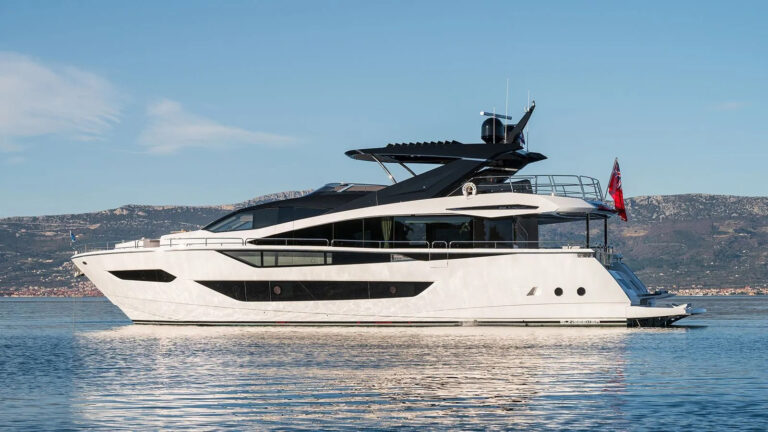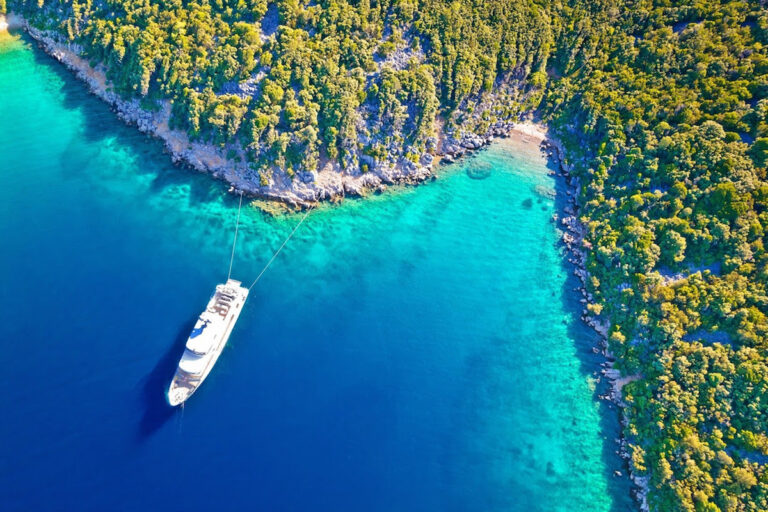
ytgjune08riviera58.jpg
I always look forward to a new Riviera convertible sea trial. The Australian builder tends to be more open-minded in terms of design than most who compete in this active market. The new 58 Enclosed Flybridge can be used for fishing and cruising-the essence of a convertible design. However, Riviera has added a third component to this iconic American genre. The 58 has a Euroyacht flavor that takes convertible design in a new direction.
From the outside the 58 follows the same creative path as the other semi-enclosed bridge models in the Riviera line. It is not easy penning a good looking convertible that’s less than 70 feet without having it appear top-heavy. Riviera’s design team has done a good job of diminishing this with a silky smooth unbroken sheer sweep that visually adds to her length. This effect is embellished by the 58’s long, slim window line and blacked-out house face. Like her smaller sisters (47E and 51E), her bridge is semi-enclosed with the after end fitted with isinglass. On inclement days one can ride in climate controlled comfort and, if the weather improves, drop the curtains, open the side windows, and retract the electrically operated sunroof. Those that find an enclosed bridge too confining should take a close look at this arrangement because it offers an interesting indoor-outdoor alternative.
The helm-forward design allows plenty of space for electronics. There is helm and companion pedestal seating as well as an adjacent bench seat. I would opt to mount the engine instruments on the dash instead of overhead. An L-shaped seating area with a table and a wet bar is aft. Those who favor fishing will find the second control station on the after end of the bridge essential with its clear view of the transom. Fishermen will want to add a monitor for the sounder and radar. A staircase with a door/hatch leads below to the saloon. In my opinion, the bridge has a rather interesting all-weather layout but since the 58 is “semi-enclosed” it would be best to leave the isinglass curtains in place if the weather threatens.
The cockpit has a partial mezzanine with builtin bench seating. A small bait-prep center with a sink and tackle storage is at cockpit level. There is a freezer within the bench seat and storage beneath the step that can be refrigerated and used as a drink box. In-sole storage/fish boxes are plumbed for overboard discharge and there is storage beneath the coaming. A transom livewell has a viewing port and a door/gate leads aft to a swim platform that serious fishermen will likely do without. Decks are finished in molded nonskid and steps at the cockpit sides make moving forward less of a challenge. A teak sole is offered in the cockpit and is standard on the bridge.
It is the 58’s open saloon/galley-aft arrangement that sets her apart from her competitors. While I have seen other galley-aft arrangements on convertibles over the years they have never made much sense-a sofa with a cockpit view is hard to beat. The 58 has an additional twist, however. A Euro-style opening bulkhead window creates an alfresco galley for sharing food, beverages, or fishing stories with those in the cockpit-brilliant! An L-shaped saloon sofa facing a built-in TV is forward, as is the dinette. House-face windows on convertibles are not popular in the U.S. since serious fishermen consider them unnecessary. Normally I would agree, but given the 58’s saloon-forward conguration the option is worth considering.

| | |
The 58’s three-stateroom, three-head layout is more spacious than you might expect. This is due to both smart design and the fact that the 58 actually measures almost 60 feet, not including her pulpit and platform. The midship master has an island queen and a private head with a stall shower, as does the forward stateroom (although an alternate arrangement with two single berths is offered, as well.) The third stateroom has overlapping upper and lower berths with a third head accessible from the passageway that’s home to a washer/dryer. The wider passageway and compartment doors are a plus in the U.S. market, where we tend to carry a bit more displacement. Our test boat’s high-gloss cherry interior was beautifully crafted. A teak interior is also offered and there are various soft-goods packages to choose from.
Access to the engineroom is from the cockpit. I found room to move forward on centerline but it is a bit of a crawl to get outboard of the engines. Most service points, including the 27.5 kW generator and the chilled-water air-conditioning, are easily accessible. There is also a machinery-removal hatch should major access be required. The engineroom has a gelcoat-finished fiberglass liner that adds to its generally tidy appearance. The 58’s hull and superstructure are hand laminated in female tooling. The hull bottom is solid fiberglass supported by fiberglass longitudinal stringers and fiberglass-covered marine plywood bulkheads and web frames. Foam coring is used above the chine and in the decks and superstructure to add stiffness and strength. The 58’s modular interior is fastened to the superstructure during production and lowered into the hull. This “down under” approach is a bit different but it seems to work quite well. A white gelcoat exterior finish is standard and custom Imron hull colors are offered. Riviera’s five-year warranty includes hull and systems, excluding the driveline.
My test boat was powered with a pair of 1,572-horsepower, Caterpillar C32 diesels. These engines are a good match for the 58 in terms of power and I would opt for them over the standard 1,015-horsepower Cats. She rises easily to plane without need of her tabs. In fact, I sea trialed her in shallow water that gave the boat enhanced lift and she began climbing on top at little more than 1200 rpm. I recorded a maximum speed of 37.9 knots at 2360 rpm. This is a few more turns than Cat species but when loaded with fuel and an owner’s gear she should be perfect. I noted 33.5 knots at 2100 rpm and found a relaxed cruising speed of 28 knots (1800 rpm), a good balance in terms of efficiency. The Cat electronics indicated an 84-gph fuel burn at this setting. Sound levels at the helm are pleasantly low thanks to the bridge enclosure and Riviera’s attention to sound attenuation. In all, the 58 has the comfortable and familiar feel of other Riviera products I have sea trialed.
While U.S. builders invented the convertible design, Riviera has successfully adapted it to the global market. The 58 is truly a hybrid-a crossover that offers convertible fans more options in terms of how they spend their time aboard. Whether you fish, cruise or enjoy both, she’s worth a close look.
Riviera Yachts of the Americas, (772) 4031060; www.rivierayachtsinc.com









